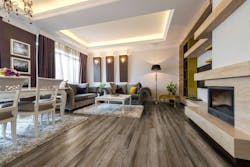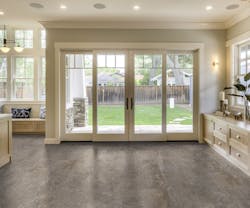Every element you select for your project is important. The flooring specification is an excellent example. Often referred to as “the fifth wall,” the floor is critical to not only the aesthetic, but also the functionality of the space. Its expanse and utility demand careful attention.
However, specifying the right floor can be a challenge, even for the most experienced professional. That’s because flooring, as with so many building materials, has advanced with amazing speed over the years in terms of ingredients, engineering, durability, sustainability and certifications. It’s hard to keep up with it all. (Photo: Engage Sugarwood Maple; Credit: MetroFlor)
Setting the Record Straight on Hard Surface Flooring
When thinking about hard surface flooring (meaning everything but carpet and area rugs), some people have misconceptions and outdated information. To begin, let’s address some basic statements people think when they hear the term hard surface.
[On Topic: Resilient Floor Covering Institute]
Statement: All hard surface flooring is basically alike.
Truth: That’s false. Just because the surface isn’t soft like tufted carpet doesn’t mean it’s all generally the same. There’s a world of difference between a natural marble stone tile and a luxury vinyl tile that’s made to look like marble. Depending on the application, both have different advantages and disadvantages.
Insight: Don’t base your specification on age-old preconceived notions of flooring types. Understanding different flooring options can lead to more possibilities.
Statement: Synthetic floors, such as vinyl or rubber, are no more or no less sustainable and safe to use than floors made of natural materials, such as stone, clay (ceramic/porcelain) or hardwoods.
Truth: That’s actually true. All flooring today is manufactured under exacting standards for supply chain management, energy use, waste recycling, etc. While there have been a few notable exceptions (such as unsafe VOC formaldehyde levels reported in some laminate flooring brand in the mid-2010s), those are rare.
Insight: Evaluate your specification for sustainability and safety based on third-party certification and transparency, not on whether it’s natural or synthetic.
Statement: You can’t compare the beauty of real stone or wood to the artificially created surface.
Truth: That’s not really true anymore. For example, ceramic wood-looking “planks” appear like the actual hardwood they mimic, but without the propensity to scratch easily. And some luxury vinyl brands are direct printing wood looks at 720 dpi and with an embossed-in-register surface so real you’d need a magnifying glass to tell the difference.
Insight: Trust your own eyes and touch. Examine product samples for yourself.
Statement: The failure of most flooring can be traced to its installation.
Truth: That’s true. Flooring relies heavily on the quality of its installation to determine the success of its performance. In today’s highly technological process, actual manufacturing defects are almost zero. However, human error in how the floor is installed, the condition of the subfloor, the presence of moisture migration from beneath, or the quality of adhesive or grout are all a few of the variables that can affect the outcome, appearance and performance of the floor you’ve specified.
Insight: The professionalism of the installer is as important as the specification of the floor to ensure the desired outcome for your project.
Photo: Metroflor Carlsbad; Credit: Metroflor
Criteria Specifying Hard Surface Flooring
This brings us to the criteria for flooring specification. What are the most important criteria you should consider for your project? Cost? Aesthetic? LEED points? Availability? Performance? Longevity? Ease of maintenance?
Actually, all of those are important. Assigning the priority comes from understanding your client’s needs and making your recommendation accordingly. Note the word “needs” not “wants.” Those may be two different things.
Hard surface flooring is trending in popularity over soft surface in commercial and residential installations for a variety of reasons. In commercial spaces, modular carpet is still popular (particularly in office settings), but the combination of hard surface, modular carpet and area rugs is beginning to make inroads with exciting design possibilities. On the residential side, there continues to be a preference for hard surface vs. carpet when it comes to concerns regarding indoor air quality, allergens and dust.
Depending on the category you consider, hard surface flooring can offer a number of commercial space advantages:
- Hardwood: High value perception, status and luxury.
- Engineered wood: Less expensive than true hardwood.
- Ceramic tile: Resistance to wear in high-traffic areas.
- Porcelain tile: Resistance to wear.
- Natural stone: Luxury status and wear resistance.
- Laminate: Wear and impact resistance.
- Resilient flooring: All of the above, depending on the type you specify.
[On Topic: Room Guide Flooring Coatings Commercial Space]
Understanding Resilient Flooring
Resilient flooring is the hard surface category that is experiencing the fastest growth. For the specifier, resilient flooring meets all the advantages previously mentioned and can be suitable for both residential and commercial spaces.
Resilient is comprised of a variety of flooring types:
- Vinyl composition tile (VCT) is probably the most familiar resilient flooring type since it’s used often in schools, retail and institutional spaces because of its durability and low cost. It’s called “composition” tile because it’s made with limestone. Today’s VCT offers design possibilities to go along with its high-traffic performance.
- Flexible luxury vinyl tile (LVT) comes in both planks (made to look identical to wood) and tiles (made to resemble stone or ceramic). Flexible LVT, when installed with adhesive, provides a low-cost floor for high-traffic environments. Loose-lay flexible LVT is becoming a popular easy-to-install floor because it requires no adhesive but lays firmly in place.
- Sheet vinyl is an engineered solution for many commercial applications. Sheet vinyl flooring installs with adhesive and has fewer seams, making it ideal for healthcare environments. There are two types of sheet vinyl:
- Heterogeneous, made of multiple layers, like LVT
- Homogeneous, made with a single, through-color layer
- Rigid core is very similar to flexible LVT, except it’s made with either an expanded polymer core (WPC) or a solid polymer core (SPC) to give the planks or tiles rigidity and a milled profile for adhesive-free, click-together installation. Rigid core is suitable where moisture is a concern or where subfloor quality may be questionable. It’s the fastest growing type of flooring on the market.
- Linoleum is often mistakenly used as a generic term for all resilient flooring. Linoleum is made from all-natural ingredients in a bio-based construction. And linoleum is making a comeback.
- Rubber includes natural, synthetic and recycled rubber. It has real practical applications where waterproof, slip resistance and anti-fatigue qualities are concerns. As with many types of resilient flooring, rubber is having its own renaissance in terms of style, colors and textures.
- Cork is like hardwood in that it’s a natural, renewable resource. But unlike hardwood, it’s flexible, warm and soft underfoot, and acts as a natural sound insulator. However, cork should not be specified for moisture-prone areas such as kitchens or baths because it absorbs moisture.
Photo: Metroflor Lysa; Credit: MetroFlor
What to Look for When Specifying a Resilient Floor
Most all flooring materials are now tested and certified by a third-party laboratory. Flooring manufacturers list their ingredients for transparency to their customer. Because we spend the overwhelming majority of our time indoors, the quality of the floors has a direct impact on the quality and healthiness of our lives.
As a result, resilient floors have a number of certifications that architects and designers should be familiar with and look for before specifying a particular floor style and brand for their project.
Manufacturing
Always look for ISO certifications validating the manufacturer’s standards for process management, environmental management and the health and safety of its employees.
Indoor Air Quality
- FloorScore was developed by the Resilient Floor Covering Institute (RFCI) and SCS Global Services to certify that the naturally occurring VOC emissions by floors are within acceptable limits, maintaining healthy indoor air quality.
- Other indoor air quality certifications may be appropriate provided they meet the requirements of the stringent California indoor air quality standard 01350.
Declarations
- Environmental Product Declaration (EPD) is a transparent, voluntary declaration of the lifecycle environmental impacts of a product. RFCI provides industry average EPDs for multiple categories of resilient flooring products and some manufactures produce individual product EPDs. Both contribute to LEED points.
- Health Product Declaration (HPD) is a report of the ingredients in a building product and the associated impact on health.
Product
- LEED means that a product has satisfied prerequisites and contributes to points for achieving different levels of certification.
- ASSURE CERTIFIED was developed by the RFCI and SCS Global Services to certify that rigid core manufacturers have appropriate quality control procedures and that rigid core flooring meets indoor air quality standards, performance and durability standards, heavy metals free and ortho-phthalates free standards.
- NSF/ANSI 332 Sustainability Assessment evaluates the sustainability of resilient flooring products including vinyl composition tile, sheet vinyl flooring, vinyl tile, rubber sheet flooring, rubber tile, linoleum sheet flooring, linoleum tile, polymeric flooring, resilient wall base and resilient stair treads. Certification to this standard enables manufacturers to demonstrate their commitment to and use of sustainability practices in the manufacture of resilient floorcoverings.
- Phthalate-Free statement, noting that vinyl flooring should be free of these chemical compounds of concern.
- Mindful MATERIALS, a common platform to communicate transparency about a manufacturer’s products to the design industry through a searchable database.
And you should always look for the right industry membership associated with the product you are specifying. For the resilient flooring category in North America, RFCI member manufacturers and suppliers must uphold the highest standards in sustainability, durability, affordability and style.
Brands who support the trade association for their category are actively involved in upholding the highest standards for manufacturing, harvesting (where applicable), shipping, packaging, safety, sustainability, recycling, installation and customer satisfaction.
See more flooring products here!
About the Author: Dean Thompson is president and CEO of the Resilient Floor Covering Institute.



